#National Diet Library
Text
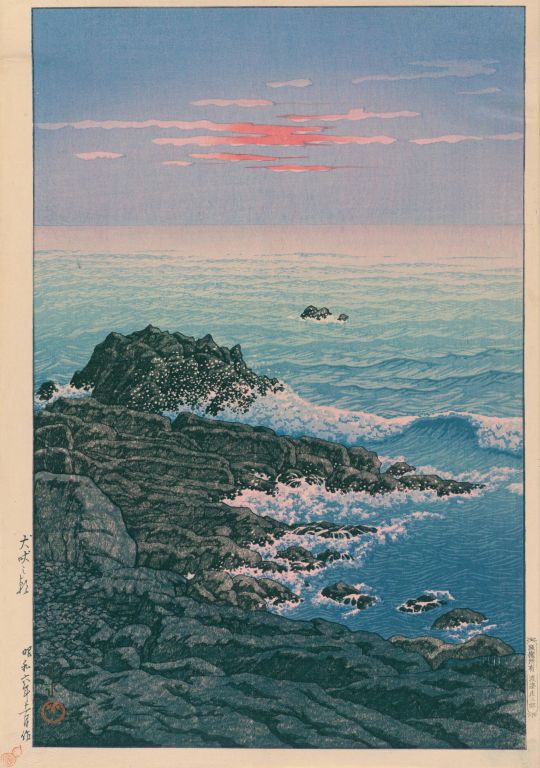
Morning at Cape Inubō, Hasui Kawase, 1931
#art#art history#Asian art#Japan#Japanese art#East Asia#East Asian art#shin-hanga#woodblock print#Hasui Kawase#Kawase Hasui#landscape#seascape#morning scene#Showa period#Showa era#20th century art#National Diet Library
2K notes
·
View notes
Text
The NDL (National Diet Library) Image Bank
The NDL (National Diet Library) Image Bank
Images via National Diet Library “NDL Image Bank”
Vectors are great and all, but for occasions when a classical spin would be more fitting for your project, look no further than the past.As reported by Time Out Tokyo, the National Diet Library—Japan’s national library and among the largest libraries in the world—regularly digitizes graphics, photos, and prints from history. These are all works…

View On WordPress
0 notes
Photo
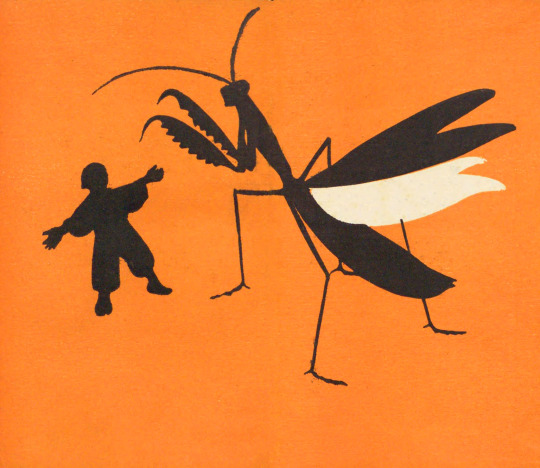

Hisui Sugiura (1876-1965), ''Nakanishiya nihon'ichi no ebanashi'' (Japan's best illustrated children's stories) by Iwaya Sazanami, 1911
Source
A couple of images from the book that I slightly cleaned up
#hisui sugiura#japanese artists#National Diet Library digital collections#iwaya sazanami#vintage art#vintage illustration
211 notes
·
View notes
Text

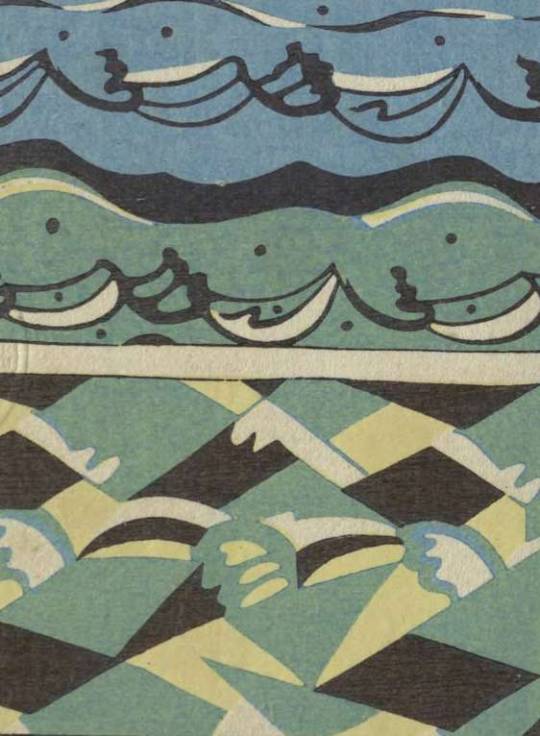



We have added a large number of images of designs to the "NDL Image Bank" of the National Diet Library of Japan! We have collected a variety of designs, mainly from collections of kimono and obi designs published in the Taisho era (1912-1926).
All of them are copyright-free and can be downloaded free of charge from the linked sites. We hope you will make use of them!
→ https://rnavi.ndl.go.jp/imagebank/index.html
41 notes
·
View notes
Note
they have a point though. you wouldn't need everyone to accommodate you if you just lost weight, but you're too lazy to stick to a healthy diet and exercise. it's that simple. I'd like to see you back up your claims, but you have no proof. you have got to stop lying to yourselves and face the facts
Must I go through this again? Fine. FINE. You guys are working my nerves today. You want to talk about facing the facts? Let's face the fucking facts.
In 2022, the US market cap of the weight loss industry was $75 billion [1, 3]. In 2021, the global market cap of the weight loss industry was estimated at $224.27 billion [2].
In 2020, the market shrunk by about 25%, but rebounded and then some since then [1, 3] By 2030, the global weight loss industry is expected to be valued at $405.4 billion [2]. If diets really worked, this industry would fall overnight.
1. LaRosa, J. March 10, 2022. "U.S. Weight Loss Market Shrinks by 25% in 2020 with Pandemic, but Rebounds in 2021." Market Research Blog.
2. Staff. February 09, 2023. "[Latest] Global Weight Loss and Weight Management Market Size/Share Worth." Facts and Factors Research.
3. LaRosa, J. March 27, 2023. "U.S. Weight Loss Market Partially Recovers from the Pandemic." Market Research Blog.
Over 50 years of research conclusively demonstrates that virtually everyone who intentionally loses weight by manipulating their eating and exercise habits will regain the weight they lost within 3-5 years. And 75% will actually regain more weight than they lost [4].
4. Mann, T., Tomiyama, A.J., Westling, E., Lew, A.M., Samuels, B., Chatman, J. (2007). "Medicare’s Search For Effective Obesity Treatments: Diets Are Not The Answer." The American Psychologist, 62, 220-233. U.S. National Library of Medicine, Apr. 2007.
The annual odds of a fat person attaining a so-called “normal” weight and maintaining that for 5 years is approximately 1 in 1000 [5].
5. Fildes, A., Charlton, J., Rudisill, C., Littlejohns, P., Prevost, A.T., & Gulliford, M.C. (2015). “Probability of an Obese Person Attaining Normal Body Weight: Cohort Study Using Electronic Health Records.” American Journal of Public Health, July 16, 2015: e1–e6.
Doctors became so desperate that they resorted to amputating parts of the digestive tract (bariatric surgery) in the hopes that it might finally result in long-term weight-loss. Except that doesn’t work either. [6] And it turns out it causes death [7], addiction [8], malnutrition [9], and suicide [7].
6. Magro, Daniéla Oliviera, et al. “Long-Term Weight Regain after Gastric Bypass: A 5-Year Prospective Study - Obesity Surgery.” SpringerLink, 8 Apr. 2008.
7. Omalu, Bennet I, et al. “Death Rates and Causes of Death After Bariatric Surgery for Pennsylvania Residents, 1995 to 2004.” Jama Network, 1 Oct. 2007.
8. King, Wendy C., et al. “Prevalence of Alcohol Use Disorders Before and After Bariatric Surgery.” Jama Network, 20 June 2012.
9. Gletsu-Miller, Nana, and Breanne N. Wright. “Mineral Malnutrition Following Bariatric Surgery.” Advances In Nutrition: An International Review Journal, Sept. 2013.
Evidence suggests that repeatedly losing and gaining weight is linked to cardiovascular disease, stroke, diabetes and altered immune function [10].
10. Tomiyama, A Janet, et al. “Long‐term Effects of Dieting: Is Weight Loss Related to Health?” Social and Personality Psychology Compass, 6 July 2017.
Prescribed weight loss is the leading predictor of eating disorders [11].
11. Patton, GC, et al. “Onset of Adolescent Eating Disorders: Population Based Cohort Study over 3 Years.” BMJ (Clinical Research Ed.), 20 Mar. 1999.
The idea that “obesity” is unhealthy and can cause or exacerbate illnesses is a biased misrepresentation of the scientific literature that is informed more by bigotry than credible science [12].
12. Medvedyuk, Stella, et al. “Ideology, Obesity and the Social Determinants of Health: A Critical Analysis of the Obesity and Health Relationship” Taylor & Francis Online, 7 June 2017.
“Obesity” has no proven causative role in the onset of any chronic condition [13, 14] and its appearance may be a protective response to the onset of numerous chronic conditions generated from currently unknown causes [15, 16, 17, 18].
13. Kahn, BB, and JS Flier. “Obesity and Insulin Resistance.” The Journal of Clinical Investigation, Aug. 2000.
14. Cofield, Stacey S, et al. “Use of Causal Language in Observational Studies of Obesity and Nutrition.” Obesity Facts, 3 Dec. 2010.
15. Lavie, Carl J, et al. “Obesity and Cardiovascular Disease: Risk Factor, Paradox, and Impact of Weight Loss.” Journal of the American College of Cardiology, 26 May 2009.
16. Uretsky, Seth, et al. “Obesity Paradox in Patients with Hypertension and Coronary Artery Disease.” The American Journal of Medicine, Oct. 2007.
17. Mullen, John T, et al. “The Obesity Paradox: Body Mass Index and Outcomes in Patients Undergoing Nonbariatric General Surgery.” Annals of Surgery, July 2005. 18. Tseng, Chin-Hsiao. “Obesity Paradox: Differential Effects on Cancer and Noncancer Mortality in Patients with Type 2 Diabetes Mellitus.” Atherosclerosis, Jan. 2013.
Fatness was associated with only 1/3 the associated deaths that previous research estimated and being “overweight” conferred no increased risk at all, and may even be a protective factor against all-causes mortality relative to lower weight categories [19].
19. Flegal, Katherine M. “The Obesity Wars and the Education of a Researcher: A Personal Account.” Progress in Cardiovascular Diseases, 15 June 2021.
Studies have observed that about 30% of so-called “normal weight” people are “unhealthy” whereas about 50% of so-called “overweight” people are “healthy”. Thus, using the BMI as an indicator of health results in the misclassification of some 75 million people in the United States alone [20].
20. Rey-López, JP, et al. “The Prevalence of Metabolically Healthy Obesity: A Systematic Review and Critical Evaluation of the Definitions Used.” Obesity Reviews : An Official Journal of the International Association for the Study of Obesity, 15 Oct. 2014.
While epidemiologists use BMI to calculate national obesity rates (nearly 35% for adults and 18% for kids), the distinctions can be arbitrary. In 1998, the National Institutes of Health lowered the overweight threshold from 27.8 to 25—branding roughly 29 million Americans as fat overnight—to match international guidelines. But critics noted that those guidelines were drafted in part by the International Obesity Task Force, whose two principal funders were companies making weight loss drugs [21].
21. Butler, Kiera. “Why BMI Is a Big Fat Scam.” Mother Jones, 25 Aug. 2014.
Body size is largely determined by genetics [22].
22. Wardle, J. Carnell, C. Haworth, R. Plomin. “Evidence for a strong genetic influence on childhood adiposity despite the force of the obesogenic environment” American Journal of Clinical Nutrition Vol. 87, No. 2, Pages 398-404, February 2008.
Healthy lifestyle habits are associated with a significant decrease in mortality regardless of baseline body mass index [23].
23. Matheson, Eric M, et al. “Healthy Lifestyle Habits and Mortality in Overweight and Obese Individuals.” Journal of the American Board of Family Medicine : JABFM, U.S. National Library of Medicine, 25 Feb. 2012.
Weight stigma itself is deadly. Research shows that weight-based discrimination increases risk of death by 60% [24].
24. Sutin, Angela R., et al. “Weight Discrimination and Risk of Mortality .” Association for Psychological Science, 25 Sept. 2015.
Fat stigma in the medical establishment [25] and society at large arguably [26] kills more fat people than fat does [27, 28, 29].
25. Puhl, Rebecca, and Kelly D. Bronwell. “Bias, Discrimination, and Obesity.” Obesity Research, 6 Sept. 2012.
26. Engber, Daniel. “Glutton Intolerance: What If a War on Obesity Only Makes the Problem Worse?” Slate, 5 Oct. 2009.
27. Teachman, B. A., Gapinski, K. D., Brownell, K. D., Rawlins, M., & Jeyaram, S. (2003). Demonstrations of implicit anti-fat bias: The impact of providing causal information and evoking empathy. Health Psychology, 22(1), 68–78.
28. Chastain, Ragen. “So My Doctor Tried to Kill Me.” Dances With Fat, 15 Dec. 2009. 29. Sutin, Angelina R, Yannick Stephan, and Antonio Terraciano. “Weight Discrimination and Risk of Mortality.” Psychological Science, 26 Nov. 2015.
There's my "proof." Where is yours?
#inbox#fat liberation#fat acceptance#fat activism#anti fatness#anti fat bias#anti diet#resources#facts#weight science#save
8K notes
·
View notes
Photo
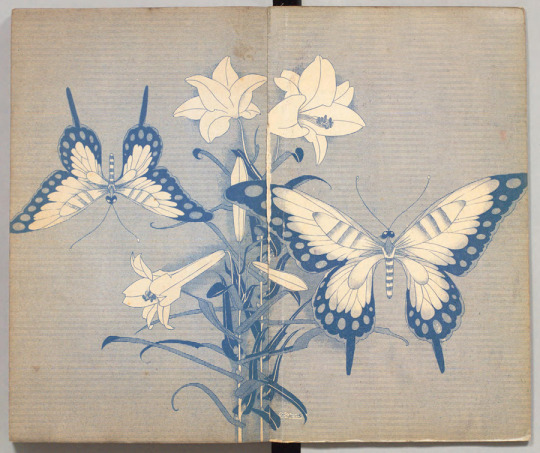
Hui, Endpapers from Story of Insects, 1928
Covers and endpapers from a series of Japanese textbooks, 小学生全集 ("Complete Works for Elementary School Students") via the National Diet Library
scan by 50wattsbooks.com
2K notes
·
View notes
Text
౨ৎ ANGEL BABY



──── 𝗆𝗂𝗅𝖺 𝗍𝗁𝗂𝗇𝗄𝗌 𝗌𝗁𝖾 𝗐𝖺𝗌 𝗆𝖺𝖽𝖾 𝗍𝗈 𝖺𝖽𝗈𝗋𝖾 𝗌𝗎𝗇𝗈𝗈
2024 pairing. 김선우 x fem!member oc cw. mentions of dieting & body image req. mila babying sunoo. ❨ back to LIBRARY ?! ❩

MILA WASN’T USED TO TAKING CARE OF OTHER PEOPLE, especially when she had grown up learning to be independent — to function without the presence of people who she could rely on, only to realise she was more lonely than anything else. So when she would innately baby her boyfriends and spoil them with affection, she surprised even herself with how natural to felt.
To care for someone, to do something kind for them, to be able to put a smile on their faces… Those were the things that Mila whole-heartedly believed she was here on this earth to do.
“Say, ‘ahhh.’” Mike lifted a fork to Sunoo’s lips, which had a chunk of her fluffy homemade pancakes covered in maple syrup and whipped cream at the end of it, topped with a sliced strawberry that would fall of any second now.
Sunoo laughed slightly before obediently allowing the girl to feed him, humming in delight as the pancake melted across his tongue in a puddle of sweetness. Mila smiled brightly, eyes sparkling with adoration as they took in the sight of his puffed cheeks and the sound of his little chirps. It wasn’t often that she looked at someone and thought, ‘I want to pinch his cheeks.’ But Sunoo had always been an exception.
“Is it good?” Mila asked. Her tone had changed to resemble the cooing that one would make to a baby. And why wouldn’t it? Sunoo was adorable, and he was technically her baby.
Sunoo nodded, his hair bouncing slightly form the movement. Mila giggled as he put his thumbs up. “It’s good!”
“Have some more.” Mila said as she poked her fork through the half-eaten pancakes on the plate. She lifted the fork up to Sunoo’s lips once again, repeating the action she had been doing for the past half an hour. And yet, it wasn’t boring or tedious in the slightest. She couldn’t think of anything she’d rather be doing.
“I think I ate too much…” Sunoo groaned as he lay down on Mila’s bed, placing a hand over his stomach. He had finished the whole plate of pancakes that Mila had made for him, unable to resist the sweetness of the fluffy treat. He pouted. “I’m so full.”
Mila giggled happily as she lay next to him, throwing her arms around him and resting her cheek against his shoulder, nuzzling it slightly. “That’s good.”
“Until I end up gaining weight, you mean,” Sunoo sighed. “I was supposed to go on diet…”
Mila immediately raised her head, a stern expression on her face. “No. You’ve already been eating less than normal. Who cares about gaining weight? It’s more important that you’re happy and healthy— and we both know you were eyeing those snacks that Jake and Riki were eating last night.”
Sunoo pouted. “But still… I should lose some of my baby fat. Especially on my face.”
“Nooooooo…” Mila leaned down to peck Sunoo’s cheek, before brushing away the hair from his face. She looked into his eyes, cupping his cheeks which she adored so much. “What about your perfect cheeks? We’d lose a national treasure if you lost any more weight… What would happen then?” She gently squished his face together. “No. I can’t live without these cheeks.”
Sunoo’s pout was replaced with a bright smile, his eyes crinkling into a familiar pair of crescent moons. “Do you like my cheeks that much?”
Mila didn’t hesitate to respond, “Of course I do.” She littered small pecks across his face, covering his skin in her love, savouring the small giggles he released in return. She pulled away, eyes sincere as they looked into his. “I love everything about you. Don’t forget that.”
Sunoo smiled, nodding in agreement. “Okay.”
He didn’t know how he would ever forget. Not when Mila was holding him so gently, as if she was holding the cusp of the world in her hands. Not when she brought his head to her chest and ran her hands through his hair while whispering how much she loved him. Not when she was calling him “baby,” “honey,” “sweetie” — every sweet name she could possibly think of — while showering him in kisses.
“This is nice,” Sunoo hummed, burying his face further into Mila’s chest. “Thank you, byeol-ah.”
Mila smiled, resting her cheek on the top of Sunoo’s head while looking at the ceiling, imagining the bright sun shining down on them through the roof. “Anything for you, xīngān.”

xīngān (“心肝”) lit. trnalsated as “heart and liver” but is a strong term of endearment more close to the english meaning of “my heart and soul”
#◌ 🌸 ˴ milana bai . ˚◞ ★̶̲ ꒱#enhypen 8th member#enhypen added member#enhypen eight member#enhypen extra member#enhypen fem oc#enhypen female member#enhypen female oc#enhypen oc#enhypen poly
128 notes
·
View notes
Text
A Culinary Journey Through Presidential History 🥪🍰🍽
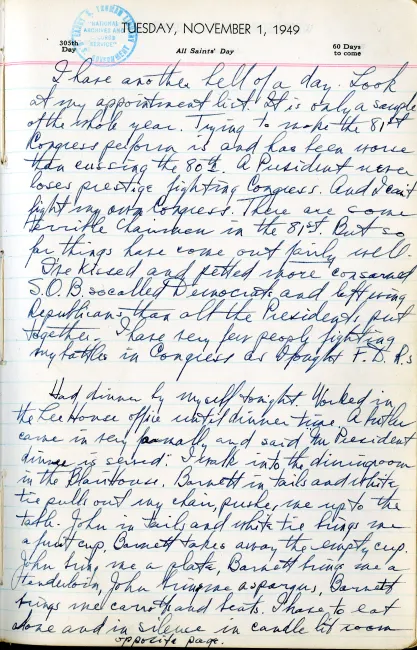
Delving into the culinary history of the White House is a fascinating exploration of taste and tradition. This article embarks on a delicious journey through time, highlighting five remarkable recipes from the kitchens of past U.S. Presidents and First Ladies. These recipes not only offer a taste of history but also reflect the diverse palates and influences that have graced the Presidential table.
Bess Truman's Bing Cherry Mold
Bess Truman, known for her skill and style in the kitchen, contributed a variety of recipes that satisfied many. Among these, the Bing Cherry Mold stands out. This dessert, a perfect blend of sweetness and texture, reflects the simplicity and elegance of the Truman era. Truman had specific dietary preferences, famously disliking onions, and maintaining a healthy diet, but this dessert was a family favorite, indicating a balance between health and indulgence.
Rosalynn Carter's Plains Cheese Ring
Rosalynn Carter's Plains Cheese Ring is a savory delight that hails from the Southern culinary tradition. This cheese appetizer, named after the Carter's hometown in Georgia, is a testament to Rosalynn's commitment to bringing a touch of home to the White House. Its rich, creamy texture paired with the tang of sharp cheddar and the sweetness of strawberry preserves, offers a unique and memorable flavor experience.

Laura Bush's Cowboy Cookies
First Lady Laura Bush’s Cowboy Cookies are a testament to her Texas roots. These chunky, flavorful cookies, packed with oats, nuts, coconut, and chocolate chips, offer a hearty taste of the American Southwest. They were notably a part of her husband's Presidential campaign, symbolizing warmth and hospitality.
Dwight D. Eisenhower's Apple Pie

President Eisenhower was not only a leader but also an enthusiastic cook, particularly known for his apple pie. His version of this classic American dessert is said to be a delightful mix of sweetness and spice encased in a perfectly flaky crust. This pie represents Eisenhower's love for simple, home-cooked meals, a contrast to his high-profile public life.
Gerald Ford's Red Flannel Hash
Gerald Ford's Red Flannel Hash is a colorful, comforting dish that combines cooked beets, potatoes, and corned beef. This dish, with its vibrant red hue and hearty ingredients, is a nod to Ford's Midwestern roots and a symbol of the simple, wholesome American fare.
www.fordlibrarymuseum.gov/library/document/0126/1489765.pdf
Exploring these recipes is not just about the flavors and ingredients; it's a journey through the different eras of American history, each dish telling a story of the time and the people in the White House. From the elegance of Bess Truman's desserts to the rustic charm of Laura Bush's Cowboy Cookies, these recipes offer a delectable glimpse into the nation's past, one plate at a time.
Read more:
167 notes
·
View notes
Text
United By Music Hatred Of The Jury
Eurovision has been dogged by allegations of cheating, corruption, bad judging calls, and hatred of the jury for many years. This year brought that to a head with Sweden’s win over the public favourite Finland, in an allocation of points that shocked Europe.
Sweden received only 243 points from the public vote, without a single “douze points” from any country. Finland received 376 votes from the public, the second highest amount ever, including the coveted 12 points from eighteen different nation-states. How, then, did Sweden manage to win? Finland was only awarded 150 points by the professional jury, while Sweden was given 340, sailing their singer Loreen, a previous Eurovision winner, to victory.
Understandably, people are upset.
One reason that Finns have said it hurt to lose to Sweden is due to their history. Finland was colonised by Sweden for over 600 years, after Sweden annexed them (a long process lasting between the 1150s and 1350s at least). Sweden is still seen as superior in a number of ways. The Finnish language is often considered weird and ugly. Käärijä, the singer representing Finland, went to Eurovision to prove that a song sung in Finnish could win.
The professional jury clearly shows bias against songs sung in native and minority languages and not English. Time and time again, they vote for the most generic pop songs instead of performances laced with languages and culture from the performing countries. Last year in 2022, France sent a song in Breton, a language with a long history of oppression in France, with Celtic iconography. They received only 9 points from the jury. Meanwhile, audiences enjoyed the performance, and were happy that France finally sent something other than a modern chanson song, French audiences included. Keiino included aspects of Sami culture and language in their song in 2019, and lost out to the Netherlands, falling several places due to the jury vote. The Eurovision Song Contest exists to showcase and celebrate the full cultural richness of the competing countries, and it is wholly wrong for the jury to penalise that.
This argument is unhelped by those that often complain about the amount of Anglophone pop songs, yet then vote for the same due to loyalty, or the attractiveness of the singer, or politics. There is nothing wrong with voting for an English language pop song if you think it is the best song that year, but one way to help these non-English language songs is to allocate them a smaller amount of votes and save the rest for your favourite. This way these countries know that other people did enjoy their performances, and that they would like to see more of the same.
During its occupation by Sweden, Swedish became the dominant language in Finland, spoken by the upper class, administration, and education. It was only under Russian rule that the Finnish language started to gain traction and recognition, finally achieving equal status as Swedish legally in 1892. This is part of why it was so important to Finns to have a winning song sung in Finnish, their only previous win being in English. To show that their language is not rough and ugly sounding, and to demonstrate what it means to sing in your native language. The crowd sang along to Käärijä’s performance in Finnish; people who are not Finnish and have never spoken a word of Finnish. I cannot imagine that feeling. Käärijä also performed topless, with a perfectly normal body, unlike the heavily chiselled bodies favoured by Hollywood, which are, only produced by extreme diets, workout regimes, and dangerous levels of dehydration. It is no surprise he became a national treasure. Finland redecorated statues and had green shrines in their libraries and supermarkets. The country was so excited. Then they lost to Sweden over the jury vote.
Norway got the third highest votes this year from the public. They also won the televoting in 2019 too, but lost because of the professional jury votes that propelled Netherlands to the win. It was said that Norway may have had some voice trouble during the finals week, including her jury performance. The BBC praised her jury performance, but Swedish newspapers allegedly said it was very rough, and that she missed nearly every note.
The professional jury doesn’t judge the same Grand Final performance that everyone else sees. The jury judges the final jury performance, a separate show where the public is not allowed and only press accredited people can attend. Performers will obviously give it their best, but that does not guarantee it will be their best performance. It is also reasonable to assume that some singers might have a lower energy performance during the jury performance due to exhaustion, or in order to save up for the grand final, among other possibilities.
It is clear that everyone needs to be voting on the same show – anything else is just blatantly unfair. Votes cannot be accurately distributed if people are voting on two different shows.
If the juries are unbiased, we have a huge problem. Even if Finland got 12 points from everyone voting in the grand final, they would have only scraped a win with 11 points. They scored the second highest votes in Eurovision history, second only to Ukraine last year, a win that itself was mired in allegations of cheating and corruption. And yet Finland still lost.
The weighting of the votes is undoubtedly tilted towards the jury. As mentioned earlier, Finland received the second highest amount of televotes in Eurovision history, and won the public vote, yet lost to Sweden based on the professional jury. This is a kick in the face to members of the public that watched and voted. It sends a clear message that the public and their opinion clearly does not matter at all and they might as well have not voted. The public pay for Eurovision, the public stream and download and buy the songs, and as such, the publics vote should count, otherwise why bother? Why have a competition?
As it stands right now, the Eurovision Song Contest is essentially voted on like a US Presidential Election. The professional jury vote is essentially the Electoral College, capable of snatching the victory from the clear public winner that secured the majority of public votes. If we are going to complain about this system being used for American elections, then there is no reason that it should be acceptable here.
One way to fix this is to change the weighting of the jury versus public votes. The professional jury was established to prevent nations from simply voting for their neighbours or allies, yet it is remarkable how often the professional juries’ votes reflect these politics anyway. A 30/70 split to the public votes will allow the jury to make clear who they think should win while also not holding enough sway to alter the public results.
An overhaul also needs to be made to the professional jury itself. It is no secret that corruption is present within Eurovision. Keeping the names of the jury secret to prevent this from happening is only going to make it impossible to know when it has happened. Instead, the jury list should be transparent, and the juries themselves should be diverse, with a number of musical styles represented. Eurovision has a wide range of musical styles perform, and having a jury compiled of industry professionals from only one or two genres will only harm these entries, especially those that draw on traditional music styles. Many fan favourites were cheated by the voting system because their songs and performances weren’t “normal” or “palatable” enough for the jury. As mentioned earlier, these trend towards songs that have considerable influence from the culture of the country, including native and minority languages. It was also caused by the “war” between the juries, as evidenced by the graphic put out by Eurovision showing the difference between the jury favourites and the public favourites. Sweden and Finland sat in the middle of each half, essentially causing a fight over who would win by each half voting only for that one country.
Worldwide voting should also be removed. There should be a return to form when it comes to who can vote, as it was last year. Those that did not pay for Eurovision should not be able to vote, and worldwide politics could tip a win or loss by a considerable amount. The US has a population of almost 332 million people. India has a population of 1.408 billion. Imagine if any country with a population like this had even a fraction of its people cast a vote based on socio-political reasons.
Even within the voting process itself, there are problems. Votes should cost the equivalent amount everywhere. It ranges from 15p/17ct up to over a euro to vote, depending on where you are. This is going to have an impact on who can vote, and therefore who will win. Even on the app, it costs money to vote. This will not be a fair competition until everyone can vote equally and the organisers need to get on top of this rapidly.
Equality is the basis of every democratic vote, but Eurovision does not treat all of its competitors equally. The Eurovision Song Contest explicitly acknowledged the war in Ukraine and the need for another nation to host because of it. They sanctioned Russia by banning them from entering, this year being the second year in a row after their initial ban last year. This is considered the right thing to do, but it has raised several questions. The Eurovision Song Contest declined to let Ukrainian President Volodymyr Zelenskyy address the audience at the grand final, saying that it would politicise the event, ignoring the fact that they had already politicised it by acknowledging the very real events happening in the world that caused something as drastic as a change of host nation. They also politicised it by denying Russia entry. The politics are even implied in the theme. While seen as the correct thing to do, it means they have, to an extent, been hypocritical. They have then taken it one step further though, with the inclusion of Israel.
Israel’s participation has long been debated due to geographical location and politics. However, to ban Russia for the invasion and war against Ukraine while allowing Israel to compete is hypocrisy at its finest. Israel has carried out the same actions against Palestine as Russia has against Ukraine, yet they have not been banned. Instead, they have hosted in recent years, often receive a decent amount of points, and this year had a previous winner featured during the interval act. Many people with the job of awarding points made statements in support of “peace and unity!” only to immediately award points to Israel.
This disparity of treatment is most obvious at two previous competitions. Israel hosted in 2019 when the Icelandic group Hatari famously waved Palestinian flags during the grand final, causing them to be deported and banned from the country. They were later fined for breaking the no politics rule.
In 2021, the Israeli entry was a song called ‘Set Me Free’, a song title that was mocked and by many for its irony. The day before the grand final, Israel launched a missile strike against Palestine (reminiscent of the harrowing news that the hometown of the Ukrainian entry was bombed moments before they took to the stage this year simply from the other perspective) as part of a series of escalations that included threatening to evict Palestinian families from East Jerusalem and nightly clashes between Palestinians and the police during the Muslim holy month of Ramadan. Many people felt that it was wrong for the performance to go ahead. For a considerable time, YouTube searches for Israel’s grand final performance only returned results for the semi-final.
Despite all this, Israel faced no sanctions at Eurovision. Contrasted with Russia, who has faced sanctions for their actions in Ukraine, fans are understandably angry and upset with Eurovision’s lack of consistent positioning on this issue, calling for the end of the hypocrisy. The double standard shown here, in the disparity of Eurovision’s treatment of Russia and Israel, is a symptom of racialised Eurocentrism – something which remains a massive problem in Europe and a subject which deserves its own post.
Speaking of the war, the UK did not utilise enough Ukrainian talent, or songs. The UK hosted on behalf of Ukraine, yet little of Ukraine was represented. Previous performers Verka, Go_A, and Jamala (who herself faced controversy for her entry at the time, it being an allegory to Russia’s invasion of Ukraine in the same year as the title under the excuse of “allying with Nazis”) returned to sing their Eurovision entries, and last year’s winners Kalush Orchestra returned with an extended opening sequence. Beyond this, and one Ukrainian presenter, Ukrainian representation was far below what it should have been. Other Ukrainian groups or previous entries should have been invited to perform, and the three previous groups that performed should have had the option to sing additional songs if they wanted to. This was a serious let-down by the UK, especially given the interval performance. Famous songs of Ukraine could have been sung instead, or even some of those Liverpudlian songs translated into Ukrainian and sung by Ukrainian performers.
Moving on from those who didn’t perform to those who did: Loreen, too, is facing accusations of rudeness and arrogance. She has already won Eurovision once before and has returned to try and win again. The popular opinion is that those who have won Eurovision before should be allowed to return and perform as part of interval acts, but should not be allowed to enter again. It is unfair to the other contestants; they have already had their moment, and should move on to allow the new competitors a fair chance under the spotlight.
Viewers noticed that it was strange that the hosts kept mentioning Abba, and that a member of Abba even made a recorded appearance. Eurovision has nothing to do with Abba’s 50th anniversary next year. Abba won Eurovision for Sweden in 1974 when the UK hosted on behalf of Luxembourg. Now, 50 years later, Sweden wins Eurovision again, in the UK hosted on behalf of Ukraine, just in time for Abba’s big anniversary. No-one can deny that this coincidence seems suspicious, especially considering the jury versus public votes Sweden received and the landslide amount of votes won by Finland.
And that brings us to the plagiarism. Many fans say Loreen’s song this year, “Tattoo” is very similar to her previous winner ‘Euphoria’. An even more common accusation is that her song is very similar, or even identical to ‘Flying Free’ by Pont Aeri. Indeed, the openings are almost a complete match. It seems hard to believe that she could compose an identical opening without having heard the original at all. Sections of the instrumentals are also similar to Loreen’s entry.
Having not heard about this controversy before the grand final, the comparison this blog draws is with Abba’s ‘Winner Takes It All’. Perhaps this is why Sweden scored so many points from the jury this year? After all, Abba constructs very enjoyable, musically excellent songs. This was only noticed when my own father heard Sweden’s entry and began singing along with Abba’s lyrics, only realising that something was different when his lyrics didn’t match Loreen’s. He has been a fan of Abba since they won Eurovision and owns several records and CDs. And even he thought it was a dance remix of Abba.
During the judging section of the competition where the points are awarded, the crowd kept booing, and chanting Käärijä’s name and “cha cha cha” while the hosts were trying to announce Sweden’s victory. This chanting continued during Loreen’s victory song, as well as many other competitors immediately making their way to Käärijä to chant and support him. It was very clear who people thought the winner should be, and it was not Loreen.
No-one remembers who won the year Verka performed. They remember Verka. That’s what’s going to happen this year. This won’t be remembered as the year Loreen won Eurovision for the second time. This will be remembered as the year the juries finally went too far, and the year Finland was robbed.
Next year we should all just send our previous winners. And maybe question if Israel has a place in this competition anymore.
#eurovision#eurovision 2023#esc 2023#finland#sweden#uk#russia in eurovision#ukraine in eurovision#israel in eurovision#finnish people if we got anything wrong please let us know
203 notes
·
View notes
Photo

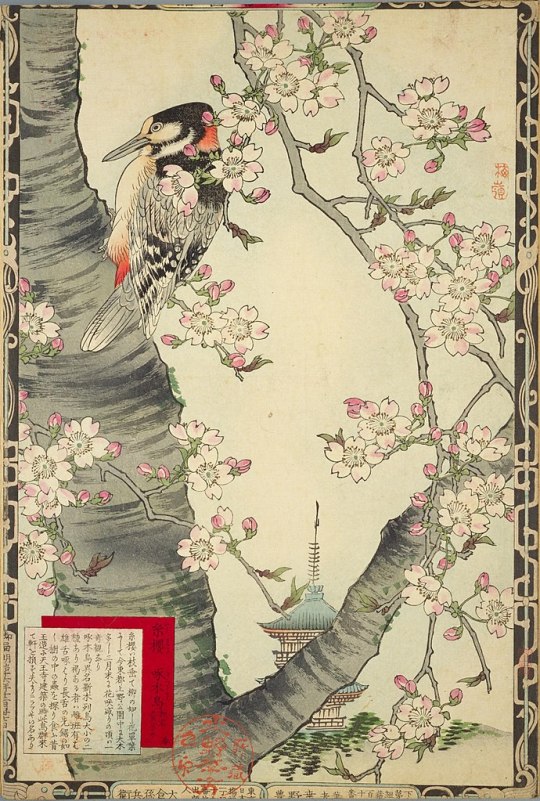



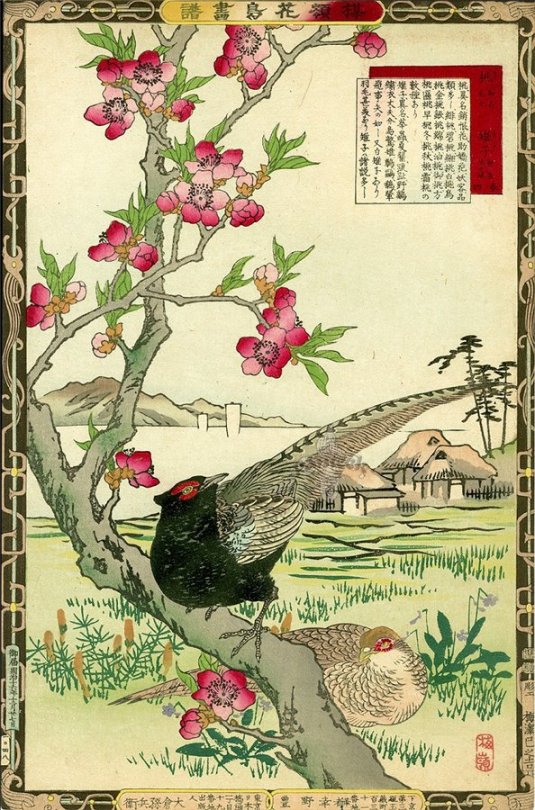

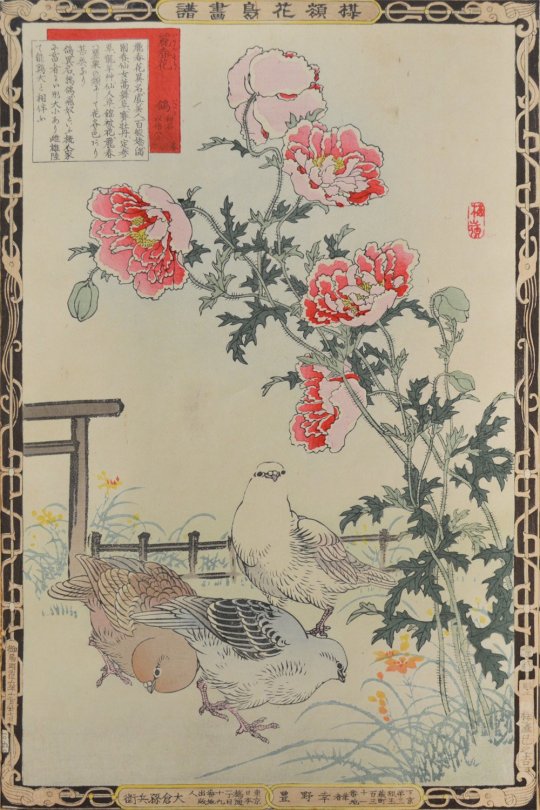
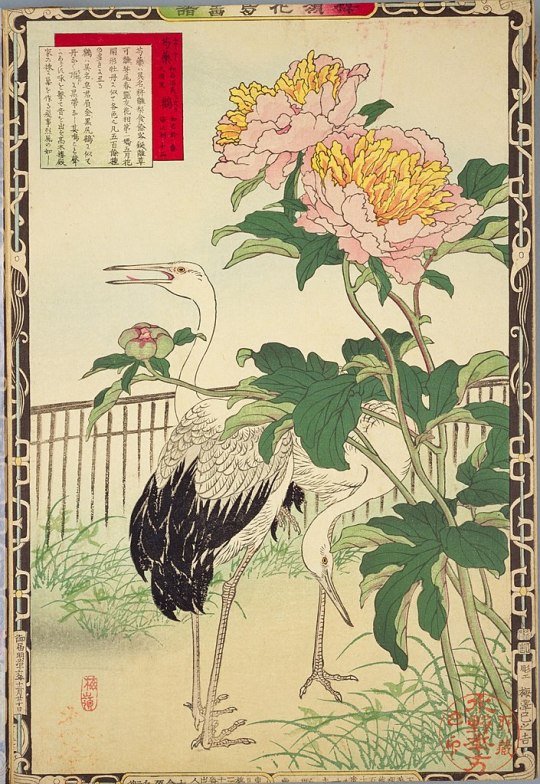
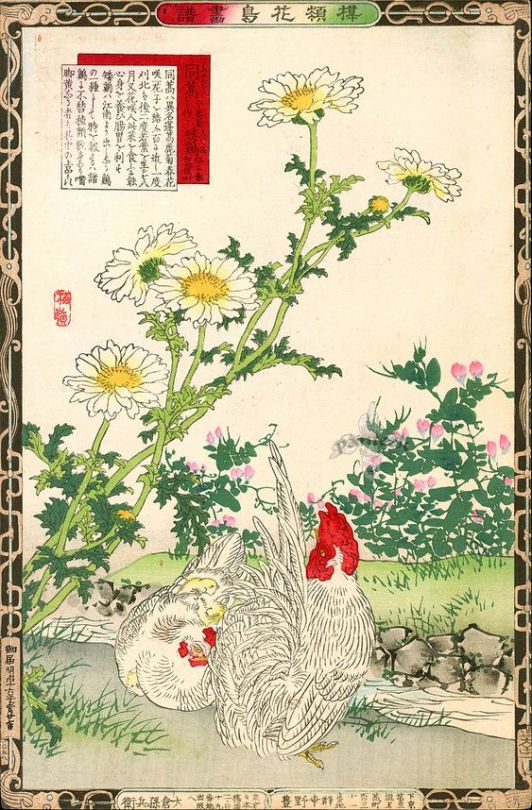
Illustrations from the series ‘Bairei kachō gafu’ by Kōno Bairei (1844-1895).
1) Plum blossom and jays
2) Drooping cherry tree and woodpecker
3) Cherry blossoms and gulls
4) Akebia quinata and azure-winged magpies
5) Japanese wisteria and white-bellied green pigeons
6) Peach blossom and green pheasants
7) Japanese magnolia and skylarks
8) Corn poppy and pigeons
9) Chinese peony and cranes
10) Garland chrysanthemum and Japanese bantams.
Woodblock prints. Published 1883. National Diet Library, Museum of Fine Arts
Wikimedia
661 notes
·
View notes
Photo
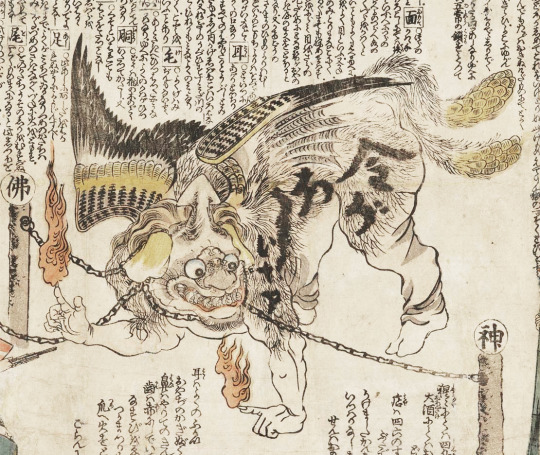
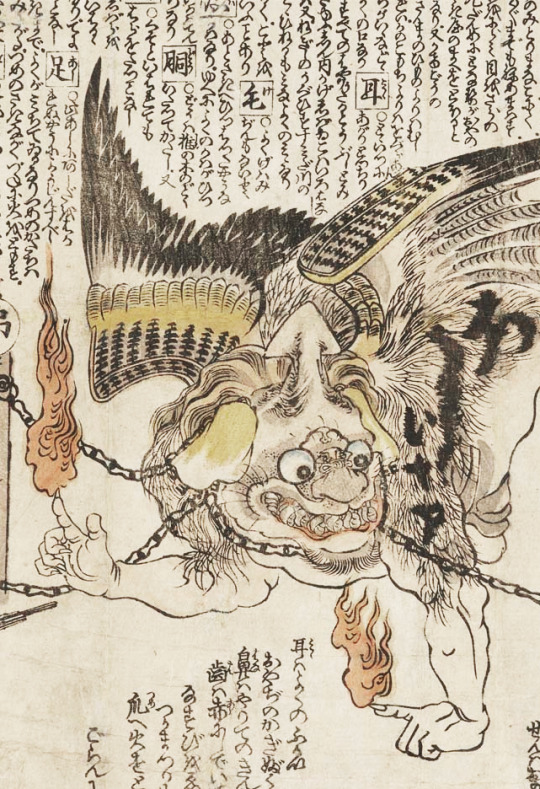
"Greed and Ifu Beast" by Kuniyoshi Utagawa. National Diet Library
594 notes
·
View notes
Text

Hachirōgata Lagoon, Akita (from the series Souvenirs of Travel III), Hasui Kawase, 1927
#art#art history#Asian art#Japan#Japanese art#East Asia#East Asian art#shin-hanga#woodblock print#Hasui Kawase#Kawase Hasui#landscape#night scene#lagoon#Showa period#Showa era#20th century art#National Diet Library
499 notes
·
View notes
Text
Japanese Illustrations From A 1925 Edition Of Aesop’s Fables By Takeo Takei
Via National Diet Library, 50 Watts.
15 notes
·
View notes
Text

Mitsushi Haneishi, ''Tales from the Land of Brahma' (梵天国物語), 1954 (Source)

Uzaburo Mino, ''Flying Horse'' (空とぶ木馬), 1954 (Source)
I'm probably not translating these titles correctly so bear with me here given my use of various "translation algorithms" to help me along.
I was digging through Japan's 'National Diet Library' to see what's buried in there and came across two books with interestingly similar panel illustrations. I couldn't dig up much more information than what's provided in the NDL archive itself on the artists but that's probably due to my own limitations given I don't read nor speak Japanese.
64 notes
·
View notes
Text
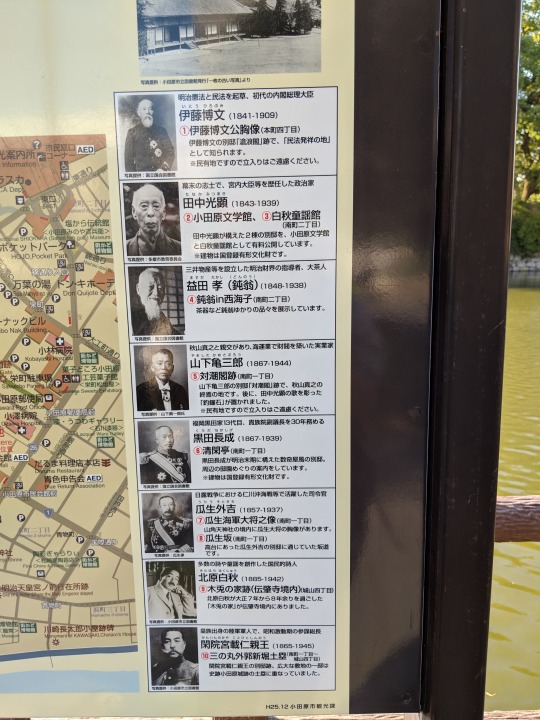
写真提供: 小田原市立図書館発行[一枚の古い写真]より
明治憲法と民法を起草、初代の内閣総理大臣
伊藤博文 (1841-1909)
1] 伊藤博文公胸像 (本町四丁目)
伊藤博文の別邸[滄浪閣]跡で[民法発祥の地]として知られます。
*民有地ですので立入りはご遠慮ください。
写真提供: 国立国会図書館
幕末の志士で、宮内大臣等を歴任した政治家
田中光顕 (1843-1939)
2] 小田原文学館、3] 白秋童謡館 (南町二丁目)
田中光顕が構えた2棟の別邸を、小田原文学館と白秋童謡館として有料公開しています。
*建物は国登録有形文化財
写真提供:多摩市教育委員会
三井物産等を設立した明治財界の指導者、大茶人
益田孝 (鈍翁) (1848-1938)
鈍翁in西海子(南町二丁目)
茶器など鈍翁ゆかりの品々を展示しています。
写真提供: 国立国会図書館
秋山真之と親父があり、海運業で財閥を築いた実業家
山下亀三郎 (1867-1944)
5] 対潮閣跡 (南町一丁目)
山下亀三郎の別邸[対潮閣]跡で、秋山真之の終焉の地です。後に、田中光顕の歌を彫った[釣鐘石]が置かれました。
*民有地ですので立入りはご遠慮ください。
写真提供:山下真一郎氏
福岡黒田家13代目、貴族院副議長を30年務める
黒田長成 (1867-1939)
[6]清閑亭 (南町一丁目)
黒田長成が明治末期に構えた数奇屋風の別邸。周辺の庭園めぐりの案内をしています。
*建物は国登録有形文化財
写真提供: 国立国会図書館
日露戦争における仁川沖海戦等で活躍した司令官瓜生外吉 (1857-1937)
7] 瓜生海軍大将之像 (南町一丁目)
山角天神社の境内に瓜生大将の胸像があります。
8] 瓜生坂 (南町一丁目)
高台にあった瓜生外吉の別邸に通じていた坂道です。
写真提供:瓜生家
多数の詩や童謡を創作した国民的詩人
北原白秋 (1885-1942)
9] 木兎の家跡(伝肇寺境内)(城山四丁目)
北原白秋が大正7年から8年余りを過ごした[木兎の家]が伝肇寺境内にありました。
写真提供: 小田原市立図書館
皇族出身の陸軍軍人で、昭和激動期の参謀総長
閑院宮載仁親王 (1865-1945)
10] 三の丸外郭新掘土塁(南町一丁目〜城山四丁目)
閑院宮載仁親王の別邸跡。広大な敷地の一部は史跡小田原城跡の土塁に重ねっていました。
写真提供: 小田原市立図書館
H25.12 小田原市観光課
Vocab
提供 (ていきょう) providing, donating
発行(はっこう)publication
憲法(けんぽう) constitution
民法(みんぽう) civil code, civil law
起草(きそう) (drafting (a bill, etc.), drawing up
内閣総理大臣 (ないかくそうりだいじん)prime minister (of a cabinet government)
伊藤博文 (いとう・ひろぶみ)Itou Hirobumi
公 (おおやけ)official, governmental, formal
胸像 (きょうぞう)half-length portrait
別邸 (べってい)secondary residence, vacation home
滄浪閣 (そうろうかく)Sorokaku
発祥の地(はっしょうのち) origin, birthplace
民有地 (みんゆうち)private land
ご遠慮ください(ごえんりょください)please refrain (from)
国立国会図書館(こくりつこっかいとしょかん)National Diet Library
幕末(ばくまつ)Bakumatsu period
志士 (しし)imperial loyalist samurai of the Bakumatsu-era
宮内大臣(くないだいじん)Minister of the Imperial Household
歴任 (れきにん)successive/consecutive jobs
政治家(せいじかん)politician, statesman
田中光顕(たんか・むつあき)Tanaka Mitsuaki
文学館(ぶんがくかん)literary museum
白秋(はくしゅう)Hakushu (see below)
童謡(どうよう)nursery rhyme
構える(かまえる)to build, set up
棟(とう)counter for buildings
有料(ゆうりょう)fee-charging
公開(こうかい)open to the public
有形文化財(ゆうけいぶんかざい)tangible cultural properties
多摩市(たまし)Tama City
三井物産(みついぶっさん)Mitsuri & Co.
設立(せつりん)establishment, foundation
財界(ざいかい)financial world, business circles
茶人(ちゃじん)master of the tea ceremony
益田孝(ますだ・たかし)Masuda Takashi
鈍翁(どんのう)Donnou, an alias he took on as a tea master
西海子(さいかいし)Saikaishi
茶器(ちゃき)tea utensils
ゆかりconnection (to a person, place, or thing)
品々(しなじな)various articles
展示(てんじ)exhibition, display
秋山真之(あきやま・さねゆき)Akiyama Saneyuki
海運業(かいうんぎょう)shipping industry, marine transport
財閥(ざいばつ)zaibatsu, financial conglomerate
築く(きずぐ)to build up, establish
実業家(じつぎょうか)business, entrepreneur
山下亀三郎(やました・かめさぶろう)Yamashita Kamesaburo
対潮閣(たいちょうかく)Taichokaku
終焉(しゅうえん)end (of life), death; (peacefully) spending one’s final years
彫る (ほる)to carve, engrave
釣鐘石 (つりがねいし)Tsurigane-ishi (Hanging Bell-shaped Rock)
代目(だいめ)nth generation
貴族院(きぞくいん)House of Peers (Meiji constitution)
副議長(ふくぎちょう)vice-chairman
黒田長成(くろだ・ながしげ)Kuroda Nagashige
数奇屋(すきや)tea-ceremony arbor
めぐり tour
教育委員会(きょういくいいんかい)board of education
日露戦争(にちろせんそう)Russo-Japanese War
における in, at, on, regarding
仁川沖海戦(じんせんおきかいせん)Battle of Chemulpo Bay (Feb. 9, 1904)
仁川(インチョン)Incheon
活躍(かつやく)activity, great efforts, active participation
司令官(しれいかん)commanding officer, general
瓜生外吉(うりう・そときち)Uryu Sotokichi
海軍大将(かいぐんたいしょう)admiral
之(の)of
山角天神社(やむかくてんじんじゃ)Yamakakuten Shrine
境内(けいだい)grounds (esp. of temples and shrines)
坂(さか)milestone; slope, hill
高台(たかだい)high ground, hill
坂道(さかみち)hill road
創作(そうさく)creative work
国民的(こくみんてき)popular on a national level
北原白秋(きたはら・はくしゅう)Kitahara Hakushuu
木兎(つく)horned owl (rarely used kanji form)
伝肇寺(でんじょうじ)Denjo-ji Temple
皇族(こうぞく)imperial family
陸軍(りくぐん)army
軍人(ぐんじん)soldier
激動(げきどう)turmoil, upheaval
参謀総長(さんぽうそうちょう)chief of general staff
閑院宮載仁親王(かんいんのみやことひとしんのう)Prince Kan’in Kotohito
外郭(がいかく)outer fence, outer enclosure
土塁(どるい)earthen walls
広大(こうだい)immense, huge, grand
敷地(しきち)site, plot, grounds
史跡(しせき)historic site
#日本語#日本#japanese langblr#japanese vocabulary#japan#japanese history#日本歴史#japanese language#Odawara#小田原
12 notes
·
View notes
Text
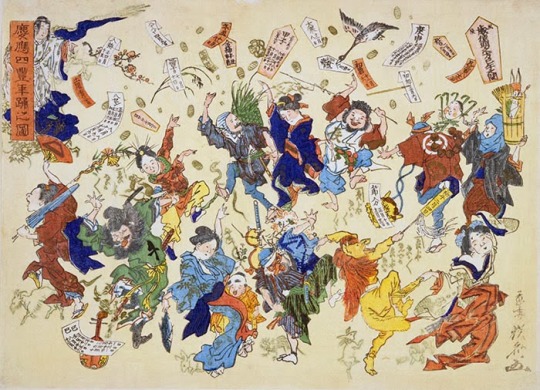
Edo period egoyomi (picture calendar) for Keio 4 (1868), showing the sho-no-tsuki (small or short months) as women and the dai-no-tsuki (large or long months) as men.
Edo Period Calendars
Disclaimer: The following information is from the National Diet Library, I didn't write this. I am sharing it for reference, both for myself and those of you who might be interested. Some slight editing for paragraphs.
...
Background / History
Japan's first calendar came from China via Korea. In the middle of the 6th century, the Yamato Imperial Court, which ruled Japan at the time, invited a priest from a country called Paekche (Kudara in Japanese), in what is now Korea, to learn from him how to draw up a calendar, as well as astronomy and geography.
Reportedly, Japan organized its first calendar in the 12th year of Suiko (604).
Back then, all matters relating to the calendar were determined by the Imperial Court. Under the Ritsuryosei system of centralized administration under the Ritsuryo legal code of the Taika Reformation, the Onmyoryo of Nakatsukasasho was in charge of the task.
An Onmyoryo was a government office that had jurisdiction over calendar preparation, astronomy, divination, etc. It was a time when calendars and divination were inseparable.
From the end of 10th century, the task of preparing the calendar was handed down in the Kamo family, while astronomy passed through generations of the Abe family, its patriarch being Abe Seimei (921-1005), noted as an Onmyo-shi, or specialist in the realm of calendars and divination.
The calendar used then was called "Tai-in-taiyo-reki," a lunisolar calendar, or "Onmyo-reki."
Each month was adjusted to the cycle of moon's waxing and waning. Since the moon orbits the earth in about 29.5 days, adjustment was required and this was done by making months with either 30 days or 29 days, the former, "dai-no-tsuki (long month)," the latter, "sho-no-tsuki (short month)."
Aside from the moon's orbit round the earth, the earth orbits the sun in 365.25 days, which, as we all know, causes the seasonal changes. Thus, merely repeating long and short months gradually produced a discrepancy between the actual season and the calendar. To compensate for this, a month called "uru-zuki," or intercalary month, was inserted every few years to produce a year with 13 months, with the order of longer and shorter months changing year by year.
Unlike our contemporary calendar in which there is no change in the order of months, back then the fixing of a calendar was deemed so important that it was placed under the control of the imperial court and, in the later Edo period, under the superimposed military shogunate.
The calendar established by Onmyo-ryo was called "Guchu-reki," one in which various words indicating seasons, annual events and daily good omens were written in Chinese characters and called "reki-chu (calendar notes)." The Guchu-reki derives its name from the fact that the notes were written in detail.
This Guchu-reki, which was in service until the Edo period, was used particularly by noblemen in ancient and medieval times, individuals based their everyday activities on the calendar. They often wrote a personal diary in the blank spaces or on the back of their personal calendar. These entries remain left valuable historical records of the era.
With the spread of kana, Japan's phonetic alphabet, "Kana-goyomi," a simplified edition of Guchu-reki written in kana, appeared. In the middle of the 14th century calendars started to be printed and soon reached a broader range of users.
As the Edo period wore on and knowledge of astronomy grew more sophisticated, the discrepancy between the calendar and actual astronomical events, such as eclipses of the sun and moon, became an issue, there arose a movement within the shogunate to amend the calendar.
Prior to then, the calendar was made each year based on the Senmyo-reki brought from China in the 4th year of Jogan (862), but as the same method had been used for more than eight centuries, it was deemed consistent with the situation prevailing at the time.
In the 2nd year of Jokyo (1685), a method of making the calendar was devised by Shibukawa Harumi, marking the first attempt by a Japanese, with the amended version known as the Jokyo calendar.
Later in the Edo period, the calendar was revised several times, the results respectively called the Horeki (1755), Kansei (1798) and Tenpo (1844) calendars.
Through these amendments, a more accurate lunisolar calendar was devised incorporating Occidental astronomy. Calendar calculation was made by the "Tenmongata" (officer in charge of astronomy) in the Edo shogunate, with notes added by the Kotokui family, descendants of the Kamo family, after which calendars were issued by publishers in various regions.
Calendars at first were exclusively for the use of the imperial court and noblemen, but after the dawn of printed calendars, more and more people came to use them.
Farmers and merchants found them essential to know the seasons and events. In particular, when using lunisolar calendars in which the order of long and short months changed year after year, learning them proved indispensable for merchants who made collections or payments at the end of each month.
Because of this, various types of calendars were devised and used.

Edo period egoyomi (picture calendar) for Tenmei 7 (1787), showing the sho-no-tsuki (small or short months) as women's parts and the dai-no-tsuki (large or long months) as men's parts in kabuki, beginning with the first month at top right.
According to the lunisolar calendar, there were long months with 30 days and short ones with 29 and their arrangement changed year by year. So knowing the arrangement of long and short months, with the inclusion of an intercalary month from time to time, was very important for the people who lived in those times.
Merchants, who made it a rule to effect payments or collections at the end of each month, would make signs to show a long or short month and erect them up in their shops according to the month in order to avoid mistakes.
While the calendar spread, the Daisho-reki calendar, which showed only the order of the long and short months, appeared during the Edo period (1603-1867). In those days it was called simply "Daisho". But instead of merely showing the length of month, it incorporated such devices as indicating long and short months with the use of pictures and sentences.
Various kinds of Daisho, including those using auspicious illustrations like the animal of the year and scenes from popular Kabuki plays, were produced and many were traded at "Daisho" New Year gatherings, while others were used for gifts. This custom began at the end of 17th century and was most popular in the latter half of the 18th century, in the Edo period.
Many noted artists produced Daisho illustrations. Later, in the Meiji era, when the solar calendar was officially adopted, Daisho calendars fell into disuse and were no longer produced.
#history notes#historical notes#history reference#historical reference#history research#historical research#calendars#calendar#japanese calendar#japanese history#edo period#lunisolar calendar
14 notes
·
View notes